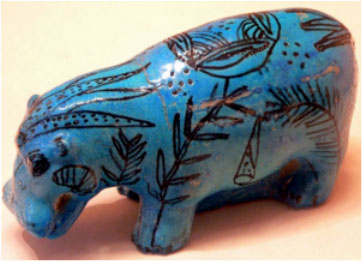From Ancient Origins:
Egyptian Blue, also known as calcium copper silicate, is one of the first artificial pigments known to have been used by man. The oldest known example of the exquisite pigment is said to be about 5000 years old, found in a tomb painting dated to the reign of Ka-Sen, the last pharaoh of the First Dynasty. Others, however, state that the earliest evidence of the use of Egyptian blue is from the Fourth Dynasty and the Middle Kingdom, around 4,500 years ago. Nevertheless, by the New Kingdom, Egyptian Blue was used plentifully as a pigment in painting and can be found on statues, tomb paintings and sarcophagi. In addition, Egyptian blue was used to produce a ceramic glaze known as Egyptian faience.
Its characteristic blue colour, resulting from one of its main components — copper — ranges from a light to a dark hue, depending on differential processing and composition. If the pigment is ground coarsely, it produces a rich, dark blue, while very finely-ground pigment produces a pale, ethereal blue. It is made by heating a mixture of a calcium compound (typically calcium carbonate), a copper-containing compound (metal filings or malachite), silica sand and soda or potash as a flux, to around 850-950 C.
In Egyptian belief, blue was considered as the colour of the heavens, and hence the universe. It was also associated with water and the Nile. Thus, blue was the colour of life, fertility and rebirth. One of the naturally blue objects that the Egyptians had access to was lapis lazuli, a deep blue semi-precious stone which could be ground up into powder, although this was a luxury item and had to be imported from Afghanistan. Therefore, it is not too surprising that the Egyptians sought to produce a synthetic pigment to use as a substitute for the blue lapis lazuli.
The manufacture of Egyptian Blue eventually spread beyond Egypt’s borders, and can be found throughout the Mediterranean. Egyptian Blue has been found in numerous Greek and Roman objects, including statues from the Parthenon in Athens and wall paintings in Pompeii. Despite its extensive application in art, Egyptian Blue ceased to be used, and its method of production was forgotten when the Roman era came to an end.
In the 19 th century, Egyptian Blue was re-discovered. The excavations at Pompeii revealed that many wall paintings had Egyptian Blue on them, and this prompted scientists to investigate the exact composition of this pigment. Since then, researchers have gained a much deeper understanding of its unique properties. Experiments found that Egyptian Blue has the highly unusual quality of emitting infrared light when red light is shone onto it. This emission is extraordinarily powerful and long-lived, but cannot be seen by the naked eye, because human vision does not normally extend into the infrared range of the light spectrum. In addition, scientists unexpectedly discovered that Egyptian Blue will split into ‘nanosheets’ – a thousand times thinner than a human hair – if stirred in warm water for several days. Scientists now believe that its unique properties may make Egyptian Blue suitable for a variety of modern applications. (Read more.)


















No comments:
Post a Comment